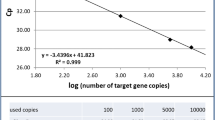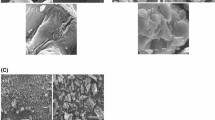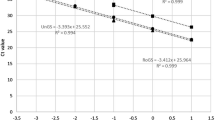Abstract
The effects of dry heating, wet heating, and extrusion on the degradation of DNA in cottonseed meal (CSM) were studied using polymerase chain reaction (PCR) and real-time PCR approach. Both the sad1 DNA, ranging between 128 and 883 bp in size, and the cry1Ab/c gene, ranging between 183 and 652 bp in size, were detectable in all dry-heated CSM and cottonseed. During wet heating, the sad1 gene (≥883 bp) and the cry1Ab/c (≥952 bp) gene were thoroughly degraded at 105 and 120 °C, respectively. Sizes from 128 to 530 bp for the sad1 gene and sizes from 183 to 652 bp for the cry1Ab/c gene were detected during extrusion at temperatures ranging from 75 to 135 °C. Fragments ≤883 bp for the sad1 gene and ≤952 bp for the cry1Ab/c gene were detected in all of the extruded samples with water content varying between 26 and 34 %. The copy number ratio of cry1Ab/c to sad1 in samples of Bt cottonseed meal decreased rapidly when the temperature increased during the heating process. In conclusion, feed processing markedly degrades the larger DNA fragments of sad1 and cry1Ab/c, with high temperature and water content being the main factors for that degradation.





Similar content being viewed by others
References
Guan, Q. F., Wang, X. M., Teng, D., Yang, Y. L., Tian, F., Yin, Q. Q., & Wang, J. H. (2011). Construction of a standard reference plasmid for detecting GM cottonseed meal. Applied Biochemistry and Biotechnology, 165, 24–34.
Wu, K. (2007). Monitoring and management strategy for Helicoverpa armigera resistance to Bt cotton in China. Journal of Invertebrate Pathology, 95, 220–223.
Liu, F., Xu, Z., Zhu, Y., Huang, F., Wang, Y., Li, H., Gao, C., Zhou, W., & Shen, J. (2010). Evidence of field-evolved resistance to Cry1Ac-expressing Bt cotton in Helicoverpa armigera (Lepidoptera: Noctuidae) in northern China. Pest Management Science, 66, 155–161.
Sherrod, L. B., & Tillman, A. D. (1962). Effects of varying the processing temperatures upon the nutritive values for sheep of solvent-extracted soybean and cottonseed meals. Journal of Animal Science, 21, 901–910.
Henry, M. H., Pesti, G. M., Bakalli, R., Lee, J., Toledo, R. T., Eitenmiller, R. R., & Phillips, R. D. (2001). The performance of broiler chicks fed diets containing extruded cottonseed meal supplemented with lysine. Poultry Science, 80, 762–768.
Mena, H., Santos, J. E. P., Huber, J. T., Simas, J. M., Tarazon, M., & Calhoun, M. C. (2001). The effects of feeding varying amounts of gossypol from whole cottonseed and cottonseed meal in lactating dairy cows. Journal of Dairy Science, 84, 2231–2239.
Zhang, W. J., Xu, Z. R., Pan, X. L., Yan, X. H., & Wang, Y. B. (2007). Advances in gossypol toxicity and processing effects of whole cottonseed in dairy cows feeding. Livestock Science, 111, 1–9.
Clark, S. P. (1969). Continuous extrusion cooking of cottonseed kernels and of partially defatted meal. Journal of the American Oil Chemists’ Society, 46, 673–677.
Arieli, A. (1998). Whole cottonseed in dairy cattle feeding: a review. Animal Feed Science and Technology, 72, 97–110.
Smith, W. A., & Vosloo, L. P. (1994). Effect of heat treatment of whole cottonseed on in vitro, in situ, and in vivo ruminant digestion characteristics. South African Journal of Animal Science, 24, 39–44.
Arieli, A., Ben-Moshe, A., Zamwel, S., & Tagari, H. (1989). In situ evaluation of the ruminal and intestinal digestibility of heat-treated whole cottonseeds. Journal of Dairy Science, 72, 1228–1233.
Barraza, M. L., Coppock, C. E., Brooks, K. N., Wilks, D. L., Saunders, R. G., & Latimer, G. W., Jr. (1991). Iron sulfate and feed pelleting to detoxify free gossypol in cottonseed diets for dairy cattle. Journal of Dairy Science, 74, 3457–3467.
Gryson, N. (2010). Effect of food processing on plant DNA degradation and PCR-based GMO analysis: a review. Analytical and Bioanalytical Chemistry, 396, 2003–2022.
Chiter, A., Forbes, J. M., & Blair, G. E. (2000). DNA stability in plant tissues: implications for the possible transfer of genes from genetically modified food. FEBS Letters, 481, 164–168.
Kharazmi, M., Bauer, T., Hammes, W. P., & Hertel, C. (2003). Effect of food processing on the fate of DNA with regard to degradation and transformation capability in Bacillus subtilis. Systematic and Applied Microbiology, 26, 495–501.
Ogasawara, T., Arakawa, F., Akiyama, H., Goda, Y., & Ozeki, Y. (2003). Fragmentation of DNAs of processed foods made from genetically modified soybeans. Japanese Jounal of Food Chemistry, 10, 155–160.
Bauer, T., Hammes, W. P., Haase, N. U., & Hertel, C. (2004). Effect of food components and processing parameters on DNA degradation in food. Environmental Biosafety Research, 3, 215–223.
Moreano, F., Busch, U., & Engel, K. H. (2005). Distortion of genetically modified organism quantification in processed foods: influence of particle size compositions and heat-induced DNA degradation. Journal of Agricultural and Food Chemistry, 53, 9971–9979.
Murray, S. R., Butler, R. C., Hardacre, A. K., & Timmerman-Vaughan, G. M. (2007). Use of quantitative real-time PCR to estimate maize endogenous DNA degradation after cooking and extrusion or in food products. Journal of Agricultural and Food Chemistry, 55, 2231–2239.
Vijayakumar, K., Martin, A., Gowda, L. R., & Prakash, V. (2009). Detection of genetically modified soya and maize: impact of heat processing. Food Chemistry, 117, 514–521.
Chen, Y., Ge, Y., & Wang, Y. (2007). Effect of critical processing procedures on transgenic components in quality and quantity level during soymilk processing of Roundup Ready Soybean. European Food Research and Technology, 225, 119–126.
Forbes, J., Blair, G., Chiter, A., & Perks, S. (1998). Effect of feed processing conditions on DNA fragmentation. Final report on CS0116 to the ACNFP, 19.
Van Der Colff, L., & Podivinsky, E. (2008). Cooking DNA: the effect of ‘domestic’ cooking methods on detection of GM potato. International Journal of Food Science and Technology, 43, 2105–2112.
Teletchea, F., Maudet, C., & Hanni, C. (2005). Food and forensic molecular identification: update and challenges. Trends in Biotechnology, 23, 359–366.
Yoshimura, T., Kuribara, H., Matsuoka, T., Kodama, T., Iida, M., Watanabe, T., Akiyama, H., Maitani, T., Furui, S., & Hino, A. (2005). Applicability of the quantification of genetically modified organisms to foods processed from maize and soy. Journal of Agricultural and Food Chemistry, 53(6), 2052–2059.
Winterholler, S., Lalman, D., Hudson, M., & Goad, C. (2009). Supplemental energy and extruded-expelled cottonseed meal as a supplemental protein source for beef cows consuming low-quality forage. Journal of Animal Science, 87, 3003–3012.
Buser, M. D., & Abbas, H. K. (2002). Effects of extrusion temperature and dwell time on aflatoxin levels in cottonseed. Journal of Agricultural and Food Chemistry, 50, 2556–2559.
Lindahl, T. (1993). Instability and decay of the primary structure of DNA. Nature, 362, 709.
Rudi, K., Naterstad, K., Drømtorp, S., & Holo, H. (2005). Detection of viable and dead Listeria monocytogenes on gouda-like cheeses by real-time PCR. Letters in Applied Microbiology, 40, 301–306.
Murray, S. R., Butler, R. C., & Timmerman-Vaughan, G. M. (2009). Quantitative real-time PCR assays to detect DNA degradation in soy-based food products. Journal of the Science of Food and Agriculture, 89, 1137–1144.
Acknowledgments
This study was supported by the National Major Project of Breeding for Genetically Modified Organism in China (no. 2009ZX 08012-012B) and the National Natural Science Foundation of China (no. 31201828).
Conflict of Interest
None.
Author information
Authors and Affiliations
Corresponding author
Additional information
Qingfeng Guan and Xiumin Wang contributed equally into this paper.
Rights and permissions
About this article
Cite this article
Guan, Q., Wang, X., Teng, D. et al. DNA Degradation of Genetically Modified Cottonseed Meal During Feed Processing. Appl Biochem Biotechnol 169, 368–379 (2013). https://doi.org/10.1007/s12010-012-9982-3
Received:
Accepted:
Published:
Issue Date:
DOI: https://doi.org/10.1007/s12010-012-9982-3




